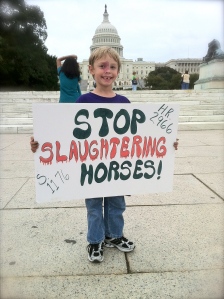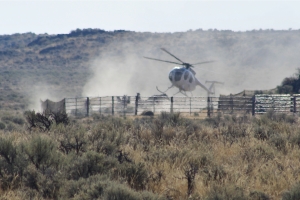AWHPC Note: In the summer of 2010, the BLM rounded up all the wild horses (196) from the Saylor Creek Herd Management Area in Idaho after a wildfire. Despite receiving over 3,500 public comments urging the return of all horses after it had regenerated, the BLM decided to release just 30 horses to the range. The rest of the horses are being put up for adoption, but due to the low adoption demand, the majority of horses will likely spend the rest of their lives in long-term holding facilities, never to see their families or experience freedom again.
The 30 horses returned to this 57,000-acre range will leave this HMA below the already-low allowable management level of 50 that BLM has established for this area. As in other areas, the BLM allocates the majority of forage in this federally-designated wild horse habitat area to private livestock, with 19 times more Animal Unit Months (AUMs) designated for private livestock than for wild horses.
By Kimberly Kruesi, Times News/Magic Valley.com, September 30, 2011

GLENNS FERRY • For the past year, Sheila Fraser has helped feed, clean and monitor wild horses in Boise corrals.
But all that stopped the minute she watched the herd step out from the confines of a trailer and gallop off into the wild.
“It’s an emotional day for me,” Fraser said. “I adopted my first horse out of this herd. This is probably a once-in-a-lifetime opportunity for me to see them out here like this.”
Close to 30 wild horses from the Saylor Creek Herd returned to their home range Thursday. The herd lost its habitat to the massive Long Butte Fire a little more than a year ago. As a result, U.S. Bureau of Land Management officials were forced to gather the 200-horse herd and house it in the Boise corrals.
Only a fraction of the herd was returned to the area because the BLM’s resource management plan dictates that the agency must leave room for herd growth, said spokeswoman Heather Tiel-Nelson. The BLM estimates that horse herds increase by 20 percent each year.
As for the remaining horses, some have been adopted, while the rest were moved to corrals near Salt Lake City and Carson City, Nev., Tiel-Nelson said.
Over the next few weeks, the BLM will monitor the returned horses closely to make sure the herd is adjusting to the area properly.
“The horses depend on us to provide water,” said Krystle Pehrson, a BLM wild horse and burro specialist. “We’ll be out here two to three times a week, monitoring to see how they adjust.”
The horses should be able to make the transition fairly easily since the herd contains a blend of old and young horses, Pehrson said.
The older 13-year-old horses have been raised in the area all their lives, except for the tiny stay in Boise, she said.
“These horses are creatures of habit,” she said. “They will stick together and the older ones will lead the others to food.”
Jody Pickel, a Mountain Home rancher, also adopted several horses from the herd. She said she was excited to see the horses returned to the wild.
“This herd has some beautiful horses in it,” she said. “They deserve to be out in the wild.”
But all that stopped the minute she watched the herd step out from the confines of a trailer and gallop off into the wild.
“It’s an emotional day for me,” Fraser said. “I adopted my first horse out of this herd. This is probably a once-in-a-lifetime opportunity for me to see them out here like this.”
Close to 30 wild horses from the Saylor Creek Herd returned to their home range Thursday. The herd lost its habitat to the massive Long Butte Fire a little more than a year ago. As a result, U.S. Bureau of Land Management officials were forced to gather the 200-horse herd and house it in the Boise corrals.
Only a fraction of the herd was returned to the area because the BLM’s resource management plan dictates that the agency must leave room for herd growth, said spokeswoman Heather Tiel-Nelson. The BLM estimates that horse herds increase by 20 percent each year.
As for the remaining horses, some have been adopted, while the rest were moved to corrals near Salt Lake City and Carson City, Nev., Tiel-Nelson said.
Over the next few weeks, the BLM will monitor the returned horses closely to make sure the herd is adjusting to the area properly.
“The horses depend on us to provide water,” said Krystle Pehrson, a BLM wild horse and burro specialist. “We’ll be out here two to three times a week, monitoring to see how they adjust.”
The horses should be able to make the transition fairly easily since the herd contains a blend of old and young horses, Pehrson said.
The older 13-year-old horses have been raised in the area all their lives, except for the tiny stay in Boise, she said.
“These horses are creatures of habit,” she said. “They will stick together and the older ones will lead the others to food.”
Jody Pickel, a Mountain Home rancher, also adopted several horses from the herd. She said she was excited to see the horses returned to the wild.
“This herd has some beautiful horses in it,” she said. “They deserve to be out in the wild.”
Read more here:
























